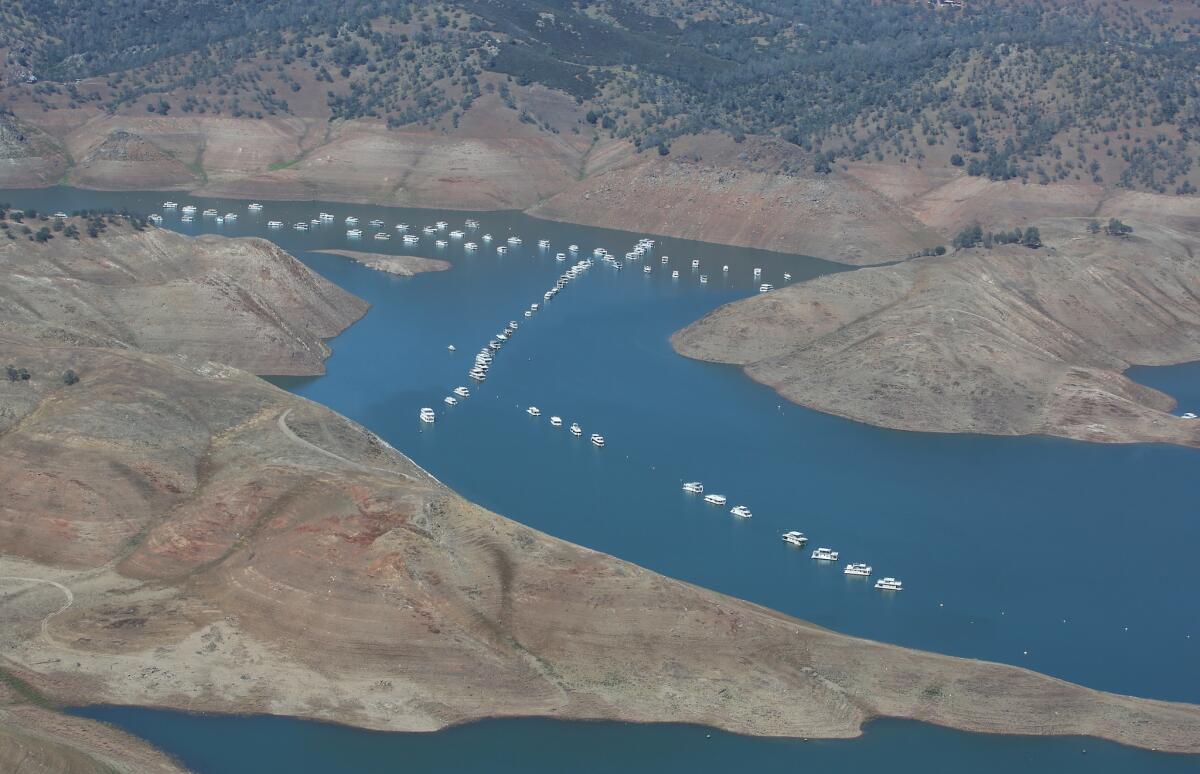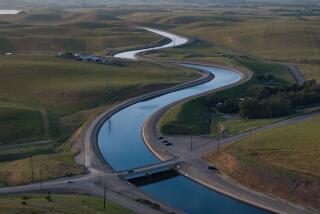California moves to restrict water pumping by pre-1914 rights holders

The receding waters of Lake McClure in Mariposa County can be seen. In a drastic action, California water officials on Friday ordered cuts in water diversions for some pre-1914 rights holders.
- Share via
For the first time in nearly 40 years, state regulators are telling more than 100 growers and irrigation districts with some of the oldest water rights in California that they have to stop drawing supplies from drought-starved rivers and streams in the Central Valley.
The curtailment order, issued Friday by the State Water Resources Control Board, has been expected for weeks. Earlier this spring, the board halted diversions under some 8,700 junior rights. With snowmelt reduced to a trickle this year, there simply isn’t enough water flowing in rivers to meet the demand of all those with even older rights predating 1914.
And as flows continue to decline this summer, board officials said, they expect to issue more curtailments, stopping river pumping by more senior diverters.
The effect of the curtailments, which affect water users with rights dating to 1903, will vary. Many have water in storage that they can continue to use. Utilities can keep using flows for hydropower production as long as the water is returned to the rivers. Some growers and ranchers also have groundwater supplies that are unaffected by the order.
A few communities, including Chico and Nevada City, have to stop river withdrawals under the order. But Thomas Howard, the state board’s executive director, said they have alternative supplies. “Each water-right holder has different options available to them,” he added.
Still, the fact that the state is reaching back more than a century in the hierarchy of California water rights highlights the withering hold of a drought that has also led to the state’s first mandatory cuts in urban use.
The last time regulators ordered those with pre-1914 water rights to stop diversions was in the punishing 1976-77 drought. Those curtailments were not as geographically widespread as Friday’s, which applies to the Sacramento and San Joaquin river watersheds as well as the Sacramento-San Joaquin Delta.
But the 1977 curtailments went back further in time. On some river stretches, they stopped withdrawals by all senior diverters.
Despite the 1977 precedent, it is likely that Friday’s order will spark appeals to the board as well as legal challenges.
“People are so dug into their rights that regardless of what we do it’s likely they will ask for a rehearing,” Delta Watermaster Michael George said last month. “There’s going to be lots of litigation coming out of this.”
Within hours of the board’s announcement, officials of the Oakdale Irrigation District in the San Joaquin Valley issued a statement saying that they were ready to seek a court injunction to put a hold on the curtailment.
“The water board is using a bulldozer when it needs a scalpel,” said Steve Knell, the district’s top official. “It does not have enough data and information to support this decision. It is based on estimates and unverified claims.”
In an interview, Knell said the district has supplies stored in several reservoirs that it can continue to draw from. “This is more of a legal issue,” he added, arguing that the state doesn’t have the authority to manage pre-1914 rights, nor does the board have accurate data on diversions by junior rights holders.
“The senior rights holders are adamantly opposed to oversight or control,” he said. “We do a good job of managing our water among our water rights group.”
Assembly Republican Leader Kristin Olsen of Modesto condemned the board action. “Today’s water grab by the state board is disappointing, but not surprising,” she said in a statement. “It is one they have been eager to do for a long time and our current drought crisis gives them the cover they’ve been looking for to follow through.”
In California and the West, most rights to surface water are based on when the water was first diverted and used, a system known as “first in time, first in right.” The oldest claims date to the Gold Rush era, when miners sucked water from streams and used it to blast gold out of the Sierra Nevada foothills.
The state didn’t start issuing water diversion permits until 1914, the dividing line between senior and junior rights.
In times of drought, when there isn’t sufficient flow to satisfy all demand, those with junior rights are cut first to leave water for those with older claims.
Last summer, the state halted diversions by many junior rights holders. In April and May, regulators again issued curtailment notices to those with junior rights in the Sacramento and San Joaquin river basins.
At the same time, the board warned those with pre-1914 rights and rights to water flowing by their property — riparian rights — that they might be soon cut.
Unusual storms in May delayed the move for several weeks as state staff monitored stream flows and demand in Central Valley watersheds.
In the Sacramento-San Joaquin Delta, growers with riparian rights volunteered last month to reduce their use by 25% this summer — a deal that headed off possibly more severe cuts by the state board.
Friday’s curtailments apply to 86 senior rights holders in the Sacramento River watershed, 14 holders in the San Joaquin River watershed and 14 in the delta. Because some holders have multiple rights, the total number curtailed Friday was 276. Those with riparian rights were not affected.
In other drought action Friday, the Obama administration announced $110 million in additional funding to provide temporary jobs for dislocated Californians, to support farmers and to improve water efficiency.
The money comes on top of more than $190 million that federal agencies have already committed to aid drought-stricken communities this year, officials said.
Twitter: @boxall
ALSO:
Rain, though welcome, brings fire hazards in drought
L.A. won’t buy power from Mojave Desert solar plant, after all
At last, California Coastal Commission says Newport Beach may keep its fire rings
More to Read
Sign up for Essential California
The most important California stories and recommendations in your inbox every morning.
You may occasionally receive promotional content from the Los Angeles Times.











